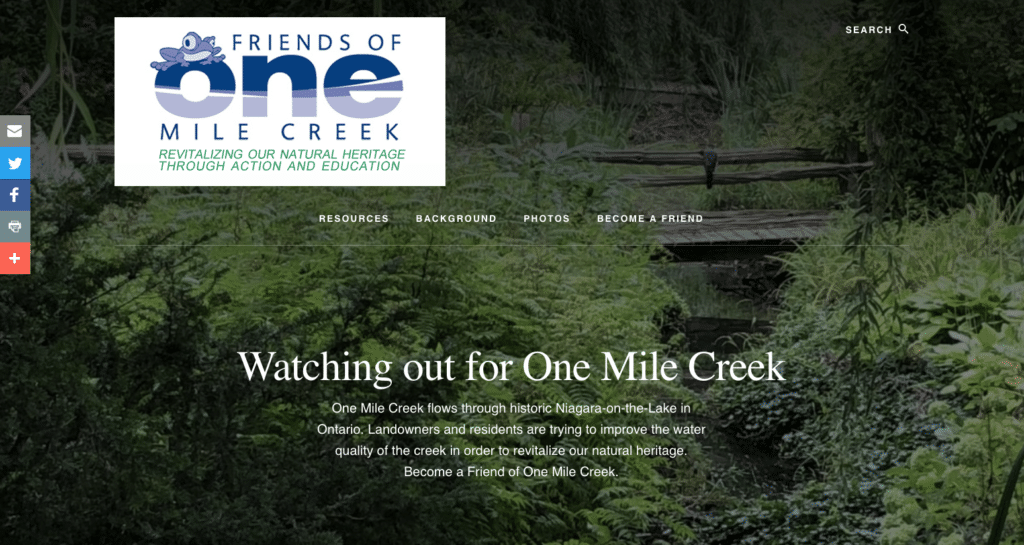One Mile Creek, which runs through Old Town in Niagara on the Lake, is back online with a new website. I’m inspired by the civic engagement of a group of NOTL volunteers, starting in 2003, known as Friends of One Mile Creek.
When we bought a house in Niagara on the Lake in 1999, I appreciated its proximity to a small creek that flows through much of Old Town. We’re not on the creek, but its flood plain skirts the back of our narrow, deep lot. Because the creek’s course follows the natural contours of the land, it twists a lot and travels at an angle across our back view. Water in the creek nourishes trees, such as willows and chestnuts, along its banks, creating for us a splendid “borrowed view” as they say in garden design.
This is One Mile Creek, named for its mouth into Lake Ontario about one mile (1.6 kilometres) from where the mighty Niagara River flows into the lake. There is One Mile Creek, Two Mile Creek, Four Mile Creek, Eight Mile Creek, as well as many more creeks such as Twenty Mile and Fifty Mile. When Europeans settled the area 200+ years ago, the main method of transportation was by water, so they numbered the creeks. It’s sort of like the numbered street names in Calgary, Vancouver or Manhattan.
In our first decade here, I was aware of a local group called Friends of One Mile Creek (FOMC) that organized annual cleanups of the creek, planted native species to replace grass along the creek, and began initiatives to improve the creek’s water quality. For instance, many houses directly connected their rain downspouts to the sewer systems, removing the benefit of allowing water to naturally percolate through soil, and overloading the creek with rain runoff more rapidly than necessary. As a result of FOMC efforts, the Town provided a subsidy to encourage residents to install rain barrels. I made sure the water off our roof travelled across our front and back gardens before heading to the creek, but otherwise I was busy with my Toronto job, and didn’t volunteer to help FOMC haul old tires out of the creek on a nice Saturday morning.
You need to appreciate that One Mile Creek runs along many private properties. There’s no way a government bureaucrat can tell people what to do. Instead, this group of volunteers who live here and worried about the creek, took action by organizing talks and displays to raise awareness about the situation. They worked closely with government agencies such as the Niagara Peninsula Conservation Authority (in the days when NPCA leadership cared about conservation rather than property development).
In the past year, we welcomed a new dog into our home, Herbie, who has short legs, and only two speeds — sniff and slow. Herbie’s a sweet boy, but his leisurely pace means that I often am paused somewhere near the creek, standing patiently while Herbie sniffs everything in sight. Looking at the creek prompted me to wonder what had happened to that local group. There’s not been any spring cleanup events in several years. And the pressures on the creek are, if anything, increasing as more woodlots are cut down to build another big new house that exceeds the recommended footprint for how much land should be built upon and how much ground should be left uncovered so that rain can percolate into the soil.

I wondered what had happened to the local group. So, I did what most of us do these days, I searched Google for “one mile creek.” Nothing. The next day, I’d try different search criteria. This wasn’t a frantic search, but I’d be reminded each morning as Herbie did his sniffing. Finally, I came across a reference to the group that included names of people. One name, Katleya Young-Chin, popped up on the LinkedIn network (which focuses on people’s careers). In May, I sent her a brief message, explaining I was curious about what had become of the group. She replied that she no longer lived in Niagara, but her mother, Klara Young-Chin, a founding member of FOMC, still lives in town.
After a few emails and phone calls, Katleya, Klara and I finally sat down to talk in late June. When we met, I was fascinated with how much the group had accomplished from 2003 to 2013. However, I also learned that the FOMC website, and all its content, had been lost in 2012. Because I know how to create websites, I offered to try to create a new one. They said there was no money, but I said that’s was fine because through other work I do I have multi-site licenses that allow me to host a new site with no incremental cost). I did pay the necessary $20 to once again register the domain name, which had lapsed. Meanwhile, they went through their files and sent me any documents and images they could find. In September, I began to create web pages and try to envision what a visitor to the new site might find useful.
Today, I think an important role for the FOMC website is to provide resources for people who want to do the right thing. As new people move into houses, they may think that it would be lovely if their back lawn ran right down to the edge of the creek. But, they also might appreciate knowing that having several feet of native plants along the bank is a much better idea, because the buffer improves water quality and helps support healthy aquatic wildlife.

The new site will also be able to gauge whether people still care about our natural heritage. If so, there is an email signup form to be a “Friend of the Creek.”
Frankly, many other creeks need their own groups of friends. Perhaps the FOMC case study will provide some ideas.
Meanwhile, I’ve come to better appreciate why I feel so with-nature in Old Town. As many of us do, I grew up and we raised children, in houses that were built on land cleared of trees, and flattened for farming, hundreds of years ago. Any small creeks were buried in pipes underground or otherwise re-routed. Then, as population grew, the farm fields were stripped of soil and planted with rows of houses. In contrast, here in Old Town, as far as I know, the creek still flows between gentle bullocks on the same course as it would have thousands of years ago when the only locals were First Nation people. They cared about the land and water. So did the people who founded FOMC. So should more of us.
Please take a look at FriendsofOneMileCreek.org.

Update: I’m now a director of FOMC
My interest in the creek, which led to my research into the Friends of One Mile Creek organization, evolved in April 2019 to my involvement as a director of FOMC as the group revitalizes its efforts in 2019.
